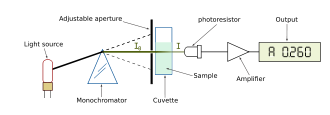


 علم الكيمياء
علم الكيمياء 
 الكيمياء التحليلية
الكيمياء التحليلية 
 الكيمياء الحياتية
الكيمياء الحياتية 
 الكيمياء العضوية
الكيمياء العضوية 
 الكيمياء الفيزيائية
الكيمياء الفيزيائية
 الكيمياء اللاعضوية
الكيمياء اللاعضوية 
 مواضيع اخرى في الكيمياء
مواضيع اخرى في الكيمياء
 الكيمياء الصناعية
الكيمياء الصناعية |
Read More
Date: 16-1-2016
Date: 6-12-2015
Date: 16-2-2017
|
Spectrophotometry
In chemistry, spectrophotometry is the quantitative measurement of the reflection or transmission properties of a material as a function of wavelength.

Spectrophotometer
A spectrophotometer is employed to measure the amount of light that a sample absorbs. The instrument operates by passing a beam of light through a sample and measuring the intensity of light reaching a detector.
The beam of light consists of a stream of photons, represented by the purple balls in the simulation shown below. When a photon encounters an analyte molecule (the analyte is the molecule being studied), there is a chance the analyte will absorb the photon. This absorption reduces the number of photons in the beam of light, thereby reducing the intensity of the light beam.
Spectrophotometry involves the use of a spectrophotometer. A spectrophotometer is a photometer (a device for measuring light intensity) that can measure intensity as a function of the light source wavelength. Important features of spectrophotometers are spectral bandwidth and linear range of absorption or reflectance measurement.
Spectrophotometers are commonly used for the measurement of transmittance or reflectance of solutions, transparent or opaque solids, such as polished glass, or gases. However they can also be designed to measure the diffusivity on any of the listed light ranges that usually cover around 200nm - 2500nm using different controls and calibrations. Within these ranges of light, calibrations are needed on the machine using standards that vary in type depending on the wavelength of the photometric determination.

Single beam spectrophotometer
There are two major classes of devices: single beam and double beam. A double beam spectrophotometer compares the light intensity between two light paths, one path containing a reference sample and the other the test sample. A single beam spectrophotometer measures the relative light intensity of the beam before and after a test sample is inserted. Although comparison measurements from double beam instruments are easier and more stable, single beam instruments can have a larger dynamic range and are optically simpler and more compact. Additionally, some specialized instruments, such as spectrophotometer built onto microscopes or telescopes, are single beam instruments due to practicality.
In short, the sequence of events in a modern spectrophotometer is as follows:
Many older spectrophotometers must be calibrated by a procedure known as "zeroing." The absorbancy of a reference substance is set as a baseline value, so the absorbancies of all other substances are recorded relative to the initial "zeroed" substance. The spectrophotometer then displays % absorbancy (the amount of light absorbed relative to the initial substance).
1- Light sources
2- Wave length selection
3- Associated optical system and slits
4- Sample holders, cells or cuvettes
5- Single beam and double beam optical paths
6- Photo-sensitive detectors
7- Output devices
8- Volume of reaction mixture
Use of blanks:
In order to measure the absorbance of samples it is first necessary to adjust the reading of the meter or other output device at each end of its range. The scale is adjusted to 100 % transmission corresponding to absorbance of Zero (this is in case of using old fashion instruments).
The setting to zero absorbance is made with a suitable reference solution in the light path for a single beam instrument or in both beams if two are used. The choice of the reference fluid will usually lie between water and one or more types of blank solutions. When reading a series of unknowns it is essential to check the zero reading at intervals and to readjust if any drift has occurred.
If water is used as a reference solution, the blank reading is subtracted from that of the test solution.



|
|
|
|
صنع الذكريات والتفكير يدمر الدماغ.. دراسة تشرح السبب
|
|
|
|
|
|
|
الصين.. عودة كاسحتي الجليد إلى شنغهاي بعد انتهاء بعثة استكشافية إلى القطب الجنوبي
|
|
|
|
|
|
جامعة الكفيل تكرم الفائزين بأبحاث طلبة كلية الصيدلة وطب الأسنان
|
|
|
|
مشروع التكليف الشرعي بنسخته السادسة الورود الفاطمية... أضخم حفل لفتيات كربلاء
|
|
|
|
ضمن جناح جمعيّة العميد العلميّة والفكريّة المجمع العلمي يعرض إصداراته في معرض تونس الدولي للكتاب
|
|
|
|
جامعة الكفيل تعقد مؤتمرها الطلابي العلمي الرابع
|